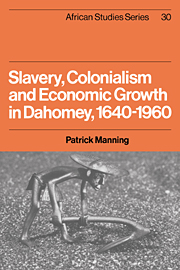Book contents
- Frontmatter
- Contents
- Maps
- Tables
- Figures
- Preface
- 1 Slavery, colonialism and economic growth, 1640–1960
- 2 The Dahomean economy, 1640–1890
- 3 Struggles with the gods: economic life in the 1880s
- 4 Production, 1890–1914
- 5 Demand, 1890–1914
- 6 Exchange, 1890–1914
- 7 The alien state, 1890–1914
- 8 Social struggles for economic ends, 1890–1914
- 9 The mechanism of accumulation
- 10 Capitalism and colonialism, 1915–60
- 11 The Dahomean national movement
- 12 Epilogue
- Notes
- Appendix 1 Export revenue from Dahomey, 1640s–1950s
- Appendix 2 Slave exports by ethnic origin
- Appendix 3 Population loss due to slave exports
- Appendix 4 Foreign trade of Dahomey
- Appendix 5 Foreign trade indices
- Appendix 6 Rainfall
- Appendix 7 Fiscal flows
- Appendix 8 Money supply of colonial Dahomey
- Bibliography
- Index
Appendix 5 - Foreign trade indices
Published online by Cambridge University Press: 26 October 2009
- Frontmatter
- Contents
- Maps
- Tables
- Figures
- Preface
- 1 Slavery, colonialism and economic growth, 1640–1960
- 2 The Dahomean economy, 1640–1890
- 3 Struggles with the gods: economic life in the 1880s
- 4 Production, 1890–1914
- 5 Demand, 1890–1914
- 6 Exchange, 1890–1914
- 7 The alien state, 1890–1914
- 8 Social struggles for economic ends, 1890–1914
- 9 The mechanism of accumulation
- 10 Capitalism and colonialism, 1915–60
- 11 The Dahomean national movement
- 12 Epilogue
- Notes
- Appendix 1 Export revenue from Dahomey, 1640s–1950s
- Appendix 2 Slave exports by ethnic origin
- Appendix 3 Population loss due to slave exports
- Appendix 4 Foreign trade of Dahomey
- Appendix 5 Foreign trade indices
- Appendix 6 Rainfall
- Appendix 7 Fiscal flows
- Appendix 8 Money supply of colonial Dahomey
- Bibliography
- Index
Summary
The export price index shown in Table A5.2 is calculated very simply: it is based entirely on the export of palm oil and palm kernels, which accounted for seventy to ninety-five percent of export values in each year. Quantities and values are taken from Tables A4.4 and A4.6; the base year is 1908, the price index is currentweighted and the quantity index is base-weighted.
Import indices are more complex because of the composition of imports and the problem of customs duties. The import indices in Table A5.1, for the years 1889–1914, were calculated as follows: proxy prices were estimated for the major import goods, since reported unit values were not dependable, as noted in Appendix 4. The proxy prices were taken from the Annual Statements of Trade in the British Parliamentary Papers, were scaled to the appropriate magnitude, and then the amount of customs duties was added to them for each year: these ‘estimated prices’ are listed in Table A4.5. They were used to calculate several import price indices. For the years 1897–1914 a narrow and dependable Index 1 was calculated for trade alcohol, gin and rum, cotton print and pipe tobacco, with a base year of 1908. Then two more indices were calculated (Index 2 with base year 1908, Index 3 with base year 1896) for the more heterogeneous but more frequently reported categories of beverages, textiles and pipe tobacco. Index 2 paralleled Index 1 from 1905 to 1914; Index 3 paralleled Index 1 from 1897 to 1904.
- Type
- Chapter
- Information
- Slavery, Colonialism and Economic Growth in Dahomey, 1640–1960 , pp. 394 - 401Publisher: Cambridge University PressPrint publication year: 1982

